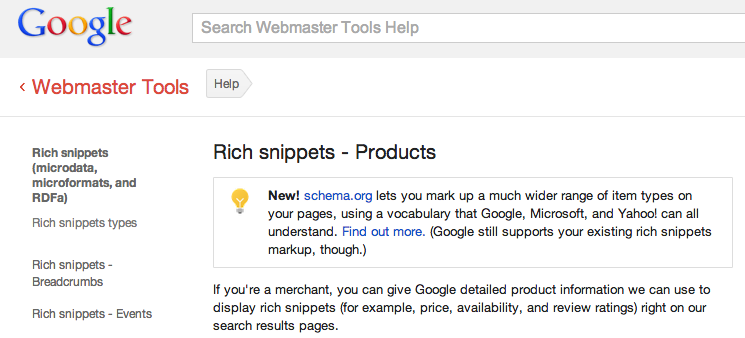An Overview
Text and images, the main components of any webpage, are easier to understand for humans than for machines. A simple fact, but something with big consequences for the way the websites and pages will need be constructed or reconstructed. Using the latest version of The HTML Editor with a drag-n-drop workflow for adding semantic markup, a lot of our customers started updating their sites in 2014. For 2015, adding semantic data remains one of the top priorities.
The future web is semantic
For years search engines have been relying on data that is invisible to humans for extracting additional meaning about the visible content. XML Sitemaps are a good example of this — not rendered on the webpage itself and therefore not directly visible to the human eye, search engines have been reading these xml files to retrieve more information about a domains URL structure and learn about each individual URL.
In a continued effort to improve the search experience Bing, Google and Yahoo teamed up (similar to what they did when standardizing the XML Sitemap Protocol) and launched schema.org in 2011. The initiative defines a vocabulary based on the microdata format for describing information — for adding meaning — to website content and HTML Markup.
The additionally supplied information about the content with the schema.org vocabulary provides a structure for search engines (and other machines) that makes it easier to (unambiguously) interpret the information. Using the vocabulary to describe website content is also often referred to as (employing) structured data.
Why it should be on your priority list for 2015
With a recent number of support announcements and tool releases, Google is increasingly emphasising structured data in general, and the schema.org vocabulary specifically, as an important method for enhancing the overall search experience.
For website owners this creates an interesting opportunity to gain more visibility in search engine results. For example, when Google announced support for structured markup for organization logos they stated:
“Markup like this is a strong signal to our algorithms to show this image in preference over others”
-RJ Ryan, Google Engineer
The main search engines increasingly rely on structured data to understand the content they are spidering and indexing. This helps them to better interpret pages and page sections, as well as to improve the results that are displayed for specific search queries.
This shift is creating a serious opportunity to gain visibility in search engine results — a chance to improve search rank for certain pages and content sections. You see, a deeper semantic understanding of the important content on a site can serve as a strong relevancy signal. The site owner makes an explicit statement what the core sections of the site are exactly about, less important sections can be de-emphasized. No, or at least very little, subjective interpretation is needed by the search engine.
Score better with semantic markup
In addition to improving relevancy, using structured data can add to the overall quality score of the domain and page. Just like a well maintained and organized business in a clean, freshly painted building will get a good review score, a well maintained website with well maintained content and clean markup using modern technologies will get a better quality score rank by the algorithms.
However, rest assured that the search engines are checking if the descriptive data and actual content match. Misrepresenting the actual content — ‘semantic spamming’ — will have a negative impact on search rank.
Another benefit of including structured data in your website is the ability to showcase rich snippets.
Google on Rich Snippets and schema.org

They make your listings more visually attractive and more informative, including detailed information and sometimes even images.
The possible downsides of using structured data
One of the negatives is that learning, adding and maintaining structured markup can be time consuming. In addition, it has to be done right. You don't want to confuse search engines or make them suspicious of 'spamming' because of markup mistakes or syntax errors.
The concerns can be addresses with The HTML Editor V14. With an easy to use workflow for adding semantic wrappers to your content, learning time is cut down to next to nothing and maintenance is easy.
Adding semantic vocabulary with The HTML Editor.

The correct syntax is automaticly inserted, the only thing you need to do is letting The Editor know what you content is about by clicking and filling in some specifcs about products, organizations, people or anything else your site can be about.
Why is this happening right now?
with the rise of voice search, on mobile but also appearing on other devices like game computers, “conversational search” is rapidly becoming key for search engines. Instead of entering keywords and keyword phrases, and tweaking them until the desired links or results are presented, searchers are becoming used to asking search engines more natural questions when typing as well. This move toward semantic or conversational search is also the main driving factor behind Google’s latest algorithm update named Hummingbird.
What this all comes down to is that when retrieving the search results, the search engine algorithms will be relying less on keywords in isolation. They will be focussing more on the context the words appear in and their meaning as defined by their relationship between them. This approach to search produces meaningful results — results that are related to what the user is looking for independent of exact word or term matches between the search query and the result.
Search engines will increasingly want to be able to understand the structure and meaning of content and pages, and will reward sites and domains that help them with that. New and redesigned sites and pages will need to take this into account going forward, existing sites will need to be updated. The engines are making it happen and early adopters might very well profit the most by getting this implemented first.

